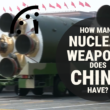How to revitalize missile nonproliferation
By Sitki Egeli |
The genie of missile technology is so far out of the bottle that getting it back in is simply unworkable, if not completely impossible. More than two dozen states have already acquired the scientific, technological, and industrial capacity to produce ballistic missiles, cruise missiles, or both. Much of the technology in question is more than 70 years old. Much missile-relevant technology, knowledge, and materials have by now become dual-use—meaning that their civilian and commercial applications are legitimate and widespread. Efforts to restrain the spread of missiles are undermined by the passage of time.
This is true in particular for export controls—a wide variety of arrangements meant to curb the flow of both finished missiles and relevant technologies and materials to nations that do not already possess them. Ever-expanding global trade is eroding, day by day, the effectiveness of export and technology controls. Easy, affordable cross-border travel is doing likewise. So are stunning advances in the storage and dissemination of data, visible in such everyday applications as the internet.
Adding to the strain, some states heretofore viewed as "good guys" on the nonproliferation scene are developing a keen interest in conventionally-tipped missiles—both ballistic missiles with relatively short ranges and cruise missiles with relatively long ranges. South Korea and Turkey are two such states. Others may join the list soon.
Why are these nations pursuing these technologies? Conventional wisdom used to maintain that ballistic missiles, unless coupled with nuclear warheads, were so inaccurate that they couldn't provide a tactically useful alternative to air power. Any state without ambitions to acquire nuclear weapons, yet with ample financial resources and the political standing needed to access advanced elements of air power, would therefore prefer combat aircraft. But not anymore. Why the shift?
In Seoul and Ankara, part of the explanation is exasperation with rivals next door—with persistent missile development in North Korea, Iran, and Russia, and with those nations' diversifying, ever-expanding missile arsenals. But equally if not more important is progress in a number of technologies that enable missile development. These include data processing and computing, miniaturization of electronics, navigation, and advanced materials. Strides in these areas are giving rise to a new generation of cruise missiles and tactical (shorter-range) ballistic missiles with greater accuracy, reliability, and affordability than their forebears of the infamous Scud generation. Shorter-range ballistic missiles, with their accuracy measured in meters, have become effective tools for taking out high-value, well-defended targets deep inside an adversary's territory. Once such a missile is fired, impact on the target is virtually guaranteed. The same can hardly be said of strike aircraft.
So if technological advances are transforming ballistic and cruise missiles into useful, affordable assets in conventional warfare, and if a strong demand-side pull results, are the days of export and technology controls over? Is it time to stop worrying about such controls altogether?
No; giving up on controls would not be wise.
Export and technology controls continue to make life difficult for existing and would-be proliferators. They increase costs, lengthen development times, and erect political and psychological barriers. But today's controls, which were devised more than three decades ago under the scope of the Missile Technology Control Regime, are in need of refocusing and readjustment. The regime's blanket restrictions are not keeping up with new developments in the field, and their impact is spread too thin. A more effective approach would be to concentrate controls on the items and sectors most critical to missile proliferation.
For example, controls could focus on longer-range missiles. The longer a missile's range, the less it depends on dual-use, widely available know-how and materials. So developing longer-range missiles presents proliferators with a number of technical and technological challenges—such as the imperative to equip missiles with a second or even a third stage. Likewise, proliferators must learn to cope with the extreme stress and heat caused by re-entry into Earth's atmosphere. These challenges saddle proliferators with increased risks and skyrocketing costs. They also demand access to a variety of specialized items and technologies—exotic materials involved in atmospheric re-entry, ingredients for propellants, and know-how for multi-staging and separation control. Export and technology controls can achieve their greatest impact if they concentrate on longer-range missiles, which already present proliferators with the greatest challenges.
Yet export controls must not be the only means to deal with missile proliferation. Another useful approach would be to limit—and ideally eliminate—all missile tests. Refining a missile's design and ensuring its reliability require multiple tests. For proliferators, therefore, the need for comprehensive flight testing constitutes an Achilles' heel; if they cannot test, their missile development and deployment will be delayed, and perhaps prevented altogether. This is especially the case for longer-range missiles. And curbing tests of long-range ballistic missiles provides a further advantage: Such missiles are the most likely candidates to carry nuclear warheads. Nascent and even established proliferators must try to confirm the reliability of their missiles. Otherwise, a malfunctioning missile launched during wartime would equate to a wasted nuclear warhead. A malfunctioning missile carrying a nuclear warhead would also create open-ended safety risks by virtue of its fissile material.
The good news is that a basis for instituting a test ban already exists: a UN-sponsored mechanism known as the Hague Code of Conduct Against Ballistic Missile Proliferation. This voluntary, non-binding agreement—adopted in 2002, with signatories now totaling more than 135—involves annual reporting of ballistic missile testing and provisions for pre-launch notification. The code's effectiveness could be reinforced and augmented in a variety of ways—for example, by expanding the code's membership, strengthening compliance mechanisms, and adding cruise missiles, hypersonic vehicles, and even missile defense to the code's purview. The code could also be revised to incorporate measures regarding transparency, confidence building, and crisis management—measures that some states have already implemented via bilateral agreements.
Finally, horizontal missile proliferation (that is, missiles spreading to a larger number of states) might be restrained through missile defense, which is rapidly maturing. To be sure, missile defense systems are extremely costly and are only available to a handful of wealthy, technologically advanced states. And missile defense umbrellas that these states extend will not reassure everyone. So perhaps an international code of conduct could be developed to provide assurances that non-missile states coming under a missile threat would automatically receive missile defense assistance from willing and able members of the international community. Such a code of conduct might be largely symbolic, and the fulfillment of its promises might depend very much on context. But a code would help establish international norms against deploying and using missiles—and would provide some peace of mind to nations that choose not to engage in missile development.
















